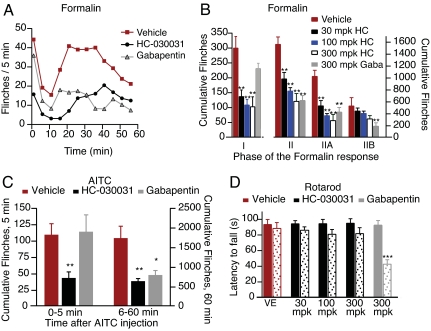Fig. 4.
HC-030031 inhibition of TRPA1 attenuates formalin- and AITC-evoked pain behavior. (A) Time course of flinching in animals treated with formalin, as measured using an automated flinch-detection system. Animals pretreated with a single injection of gabapentin (300 mg/kg i.p.; gray triangles; n = 8) or HC-030031 (black circles; n = 7) showed significantly less flinching compared with vehicle-treated animals (red squares; n = 7). (B) Quantification of the formalin response binned into different phases. Animals were pretreated with vehicle (red, n = 7), HC-030031 at 30 mg/kg (black, n = 7), 100 mg/kg HC-030031 (blue, n = 8), 300 mg/kg HC-030031 (white, n = 7), or 300 mg/kg gabapentin (gray, n = 8). Phase I (0–9 min), Phase II (10–60 min), Phase IIA (10–40 min), and Phase IIB (41–60 min). (C) Animals injected with the TRPA1 agonist, AITC, showed significant flinching that was unaffected by pretreatment with vehicle (red). In contrast, pretreatment with 300 mg/kg of the TRPA1 antagonist, HC-030031 (black), greatly reduced the flinching observed during the initial 5 min of the response to AITC. Pretreatment with gabapentin (gray) had no effect during this initial phase. During the second phase of the response (6–60 min), both HC-030031 (black) and gabapentin (gray) had an analgesic effect. (D) HC-030031 (black) has no effect on rotarod performance (n = 8). Latencies to fall were measured immediately before (solid) and 1 h after (stippled) compound treatment. No significant effect was seen with HC-030031 at dose levels ≤300 mg/kg i.p. Gabapentin (300 mg/kg i.p., gray) significantly decreased time spent on the rotarod compared with uninjected or vehicle-injected controls (red). *, P < 0.05; **, P < 0.01; ***, P < 0.001; one-way ANOVA, followed by a Bonferroni multicomparison test.

